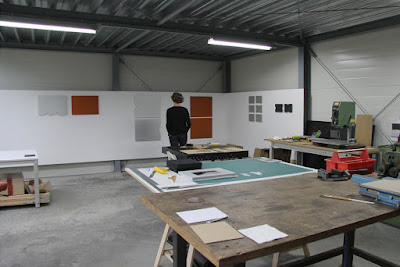My mother, Patricia Sinclair Hall, was a wonderfully creative person but didn't have the opportunity to have a career as an artist. Self-taught, she painted, batiked, wove and knitted works that followed no rules and were of startling originality. Nothing she made was exhibited in her life time
Patricia Sinclair Hall with Shandy, North Wales, 1951
Patricia was orphaned in her teens, and had little formal education. She experienced insecurity and poverty living with an older sister near Manchester, England. But she was beautiful and vivacious, and married my father, a wealthy textile mill owner, shortly before the Second World War. Thereafter, she was imprisoned in a marriage that had the outward trappings of glamour but was dominated by the tyrannical rule of my father, upon whom she was totally dependent.
Patricia was orphaned in her teens, and had little formal education. She experienced insecurity and poverty living with an older sister near Manchester, England. But she was beautiful and vivacious, and married my father, a wealthy textile mill owner, shortly before the Second World War. Thereafter, she was imprisoned in a marriage that had the outward trappings of glamour but was dominated by the tyrannical rule of my father, upon whom she was totally dependent.
Above: Patricia Sinclair Hall with Liz and Catherine, 1946, Cheshire, England
She was a stay-at-home mother (she didn't even drive a car) and was devoted to her children and house. She encouraged her four children to paint and draw, and gave me my first oil paints when I was 10. Both my sister and I went to art school when we were 16 and 15 respectively. But around that time the textile industry in Britain collapsed, and the mill went into bankruptcy. My father transferred his business to our dining room table, and the house began to fill with the yarns that he bought at auction from other mills that were closing down.
My mother wound the yarn sample cards and my father and older brother sold the fancy yarns to hand-loom weavers. I learned to make a tapestry loom and made one for my mother. Soon she was making wild weavings and embroideries with the materials close at hand (much to the disapproval of my father, who had conservative tastes).

Above: Patricia Sinclair Hall, Untitled Tapestry, circa 1975, yarn and cloth on burlap, 42 x 28 inches
After attending art school and the nearby university, desperate to escape from the confines of home, I came to the United States on a fellowship as a graduate student. In my second semester of a MA in art history I married a professor, and had our two children, Meg and Dan, shortly afterwards.
I started making art again, at first using materials I was familiar with from the textile mill of my childhood: fibers, dye, and wax resist. Like many female artists of my generation, after the publication of Germaine Greer's The Obstacle Race (1979), I wanted to prove that it was possible to be a serious artist with a rigorous studio practice, a career as a professor and a committed mother. I was a founding member of the Vermont Women's Caucus for Art and my connections with other feminist artists were instrumental to my critical awareness.

Above: Catherine Hall, Red and Black, 1985, Japanese gauze paper, wax and dye mounted on silk.
As my commitment to teaching and exhibiting increased, my marriage failed; I realized it had become as constricting as my mother's had been. However, I didn't have to stay in my marriage as she had felt she had to in hers. I needed freedom after my children were grown up to pursue my work full time. Granting myself the time to make art was my lifeline.
In the meantime, my daughter Meg had started on an artistic path of her own. She had spent every summer in England and traveled there alone at 11 to be with her cousins and -especially – my mother Patricia. She dyed and painted cloth, wound sample cards, sewed dolls and did art projects with Patricia and my sister, Liz.

Meg Lipke in Brooklyn studio, 2014. Photo by John Silvis.
Her childhood memories of her grandmother and mother have been a big influence on her work. I feel my mother's spirit has continued to blossom in my daughter's amazingly inventive art.

Above: Meg Lipke, Surplus, 2015, featuring yarn from William Hall and Co, beeswax and batiked and sewn cloth with wool stuffing, 27 x 30 x 6 in.
I see my daughter struggling to find a balance between studio practice, family, and life with admirable courage and confidence in her place in the art world; moreover to create her own supportive community of like-minded artists. Her work is fearless, uninhibited, experimental and joyful and because of the changed circumstances for women, her artistic "voice" is liberated from the confines of the patriarchal system that suppressed the voice of my mother.














































